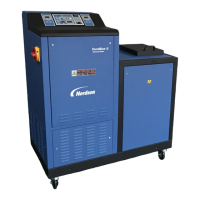Operation
4-12
Part 1126931_01
2018 Nordson Corporation
Table 4‐1 Melter Faults (contd)
Display
Code/Sub‐code
Name Affect on Melter Cause Corrective Action
F4/7
Analog‐to‐digital
calibration
Melter stops
functioning
Failed hose or
applicator
RTD analog‐to‐digital
converter could not be
calibrated (grounded
RTD in system)
Replace hose or
applicator. Note: Set
setpoint to zero to avoid
F1 fault.
Replace main board or
ribbon cable, or CPU
F4/8
Main board
feedback
Melter stops
functioning
Communication failure
between main board
and CPU
Replace main board,
ribbon cable, or CPU
F4/9
Expansion board
feedback
Melter stops
functioning
Communication failure
between expansion
board and main board
Check the ribbon cable
connections between
the expansion board
and the main board.
F4/A Thermostat
Melter stops
functioning
Tank or manifold
thermostat is open
Replace thermostat, J7
harness, or main board
F4/d
Communications
with optional I/O
card
Heaters remain on,
but fault condition
persists
Communication failure
between CPU and the
optional I/O card
Replace the I/O card or
CPU
F4/E
Fieldbus
communications
failure
Alert output (if output
option 6 is selected)
Melter continues to
operate normally.
Fieldbus card failure.
Replace the Fieldbus
card
F1, F2 and F3 Faults
When the melter detects an F1, F2, or an F3 fault:
1. The automatic scan stops and the melter begins to monitor the potential
fault for up to two minutes. The ready and heater LEDs remain on during
the two‐minute time period. If, at any time during the two‐minute period,
the melter detects that the fault condition no longer exists, the melter will
return to the automatic scan mode.
2. The LED on the affected component key (tank, hose, or applicator) turns
on to indicate the type of component that has, or is, failing.
3. The right display indicates the type of fault (F1, F2, or F3).

